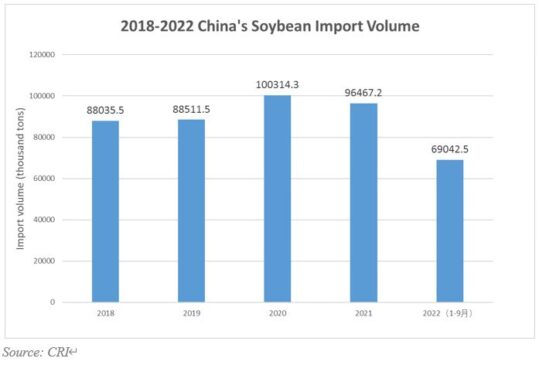Description
China’s Soybean Import Overview
With the development of China’s economy and rising living standards, the demand for soybean in the Chinese market is on the rise. Due to the limited arable land, there is little room for growth in China’s local soybean production, and China needs to import a large amount of soybean every year.
In 2021, China’s soybean imports totaled 96.467 million tons, down 3.8% year-over-year, with imports of US$53.52 billion, up 35.3%. in the first three quarters of 2022, China’s soybean imports totaled 69.043 million tons, down 6.6% year-over-year, with imports of US$46.52 billion, up 16.2%.

In 2021, the top five source countries for China’s soybean imports according to import volume were Brazil, the United States, Argentina, Uruguay and Canada. Among them, Brazil ranked first in soybean imports, with 58.147 million tons, accounting for 60.3% of total imports, and imports amounting to US$33.14 billion, or 61.9%. According to CRI’s analysis, in the first three quarters of 2022, Russia overtook Canada to rank among the top five sources of soybean imports to China for the first time, with Russian soybean imports reaching 50.0 million tons, up 12.4% year-on-year. Among soybean importers, Brazil remained at the top, with imports amounting to 46.498 million tons, accounting for 67.3% of total imports.
In 2022, China divided non-seeded yellow soybeans into two categories: genetically modified (GM) and non-GM yellow soybeans. According to CRI’s analysis, China’s soybean imports are mainly GM yellow soybeans, and China’s imports of GM yellow soybeans in the first three quarters of 2022 amounted to 67.633 million tons, accounting for 98.0% of the total imports, and the import value amounted to US$45.62 billion, accounting for 98.1% of the total imports.

CRI expects that as China’s national living standards rise, the demand for soybeans in the Chinese market will continue to rise in the coming years, while the upside of China’s domestic soybean production is effective and more than 80% of the soybeans consumed in China will still rely on imports.
Topics covered:
- China’s Soybean Import Status and Major Sources in 2018-2022
- What is the Impact of COVID-19 on China’s Soybean Import?
- Which Companies are the Major Players in China’s Soybean Import Market and What are their Competitive Benchmarks?
- Key Drivers and Market Opportunities in China’s Soybean Import
- What are the Key Drivers, Challenges, and Opportunities for China’s Soybean Import during 2023-2032?
- What is the Expected Revenue of China’s Soybean Import during 2023-2032?
- What are the Strategies Adopted by the Key Players in the Market to Increase Their Market Share in the Industry?
- What are the Competitive Advantages of the Major Players in China’s Soybean Import Market?
- Which Segment of China’s Soybean Import is Expected to Dominate the Market in 2032?
- What are the Major Adverse Factors Facing China’s Soybean Import?





Reviews
There are no reviews yet.